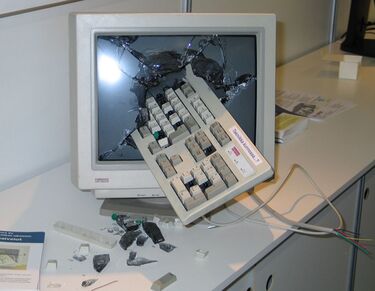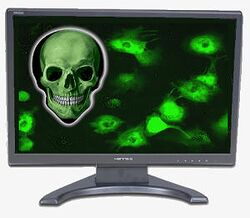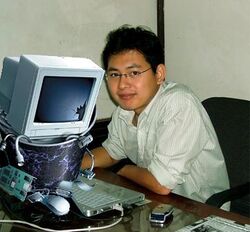HowTo:Fix a computer
Computers are marvelously complicated machines, and it is a wonder that they work at all. Unfortunately, because of this, your computer will likely stop working right one day. Maybe you're getting error messages. Maybe it runs slowly. Maybe it won't turn on. Maybe there's a raging fire billowing out from the side of its case. Essentially, it's not working like it's supposed to, and this is a problem.
But why spend big money taking it to a repair shop to be fixed by some barely-competent technician when you could just do it yourself?
Step 1: Preparation

|
HowTo This article is part of Uncyclopedia's HowTo series. See more HowTos |
Fixing a computer may seem intimidating because of the amount of lights, whistles, and technological doodads you may find crammed into your typical computer. Using one is hard enough, let alone knowing how to fix it. Never fear though: you were smart enough to know how to get to Uncyclopedia, so fixing your Uncyclopedia display unit shouldn't be that much harder! Working up the motivation and confidence is the hardest part; it gets much easier from here on out, I promise.
Step 1.1: Working up the motivation and confidence
There's a first time for everything, just like stapling toast to a wall. This will be a valuable learning experience for you. You're still probably distressed by your computer's misbehavior; take a minute to slowly inhale and exhale, or maybe go outside for a walk. Clear your mind to achieve the state of zen all great computer repair people use to pull off their magic.
Once you're sufficiently calmed down, brew up a big pot of strong coffee and chug it. You'll need the caffeine for the energy needed to make this work. And remember: you will be able to fix your computer!
Step 1.2: Identifying the problem
It is essential that you know what is generally wrong before you can fix it. There's several reasons why a computer may not be working right. Go through the following list and check off all of the matching symptoms:
- It won't turn on.
- The Internet is slow.
- Your software won't start.
- You get all sorts of error messages and warnings.
- You see the Blue Screen of Death.
- The computer gives you Blue Screen of Death Threats.
- Your computer has a virus.
- Your computer is on fire.
Review the list carefully, then throw it out and head to a nearby computer store for supplies.
Step 1.3: Getting supplies
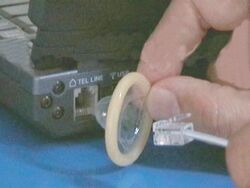
Some equipment, tools and spare parts may be needed before you can proceed. Ensure you get the following for a successful repair:
- A screwdriver, preferably magnetic
- Some anti-static supplies (wrist strap, mat, apron, condom, etc.)
- A pirated Windows CD/DVD
- Some screws, nails, and bolts
- A soldering gun and some solder
- A new motherboard
- A hammer
- A hacksaw
- Any electronics you find left out by the curb on garbage day
- A loaded gun of your choice
- Super Glue
If you're missing anything, it will mean another trip to the store or another drive around your neighborhood in the middle of your repair. Make sure everything is present, accounted for and in good condition. These are the minimum needed supplies and will all be necessary at some point of the procedure.
Step 2: The repair
Fixing a computer is pretty easy nowadays, thanks to advances in technology and the amazing process of troubleshooting. Just follow the steps below and you'll be fixing your computer like one of those Geek Squad people at Best Buy!
Step 2.1: The hardware
Cutting into your computer requires patience. If this is an emergency repair and you don't have the time, you can slice a little ways in then use the hammer to pry it open the rest of the way. (A blowtorch might work well too.)
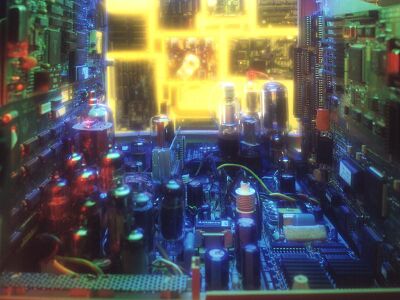
- Dress for success. Static electricity will instantly ruin any computer components it touches. To be safe, you should lay down an anti-static mat, and put on your anti-static wrist strap, anti-static apron, and anti-static boots. If you're a guy, put on the anti-static condom too so you can't contract any computer viruses. Safety first!
- Troubleshoot your computer. Take the loaded gun and fire it into your computer until it turns off. This is the only sure-fire way to make the computer stop causing trouble.
- Open the case. You might think this is what the screwdriver is for, but that's a common beginner's mistake. Take the hacksaw and carefully slice into your machine.
- Examine the innards. Look for anything that's immediately wrong with the hardware. A slow computer might be simply annoyed by the constant fan noise from the CPU heatsink fan; rip it out to keep things quiet and instantly boost performance. Tangled wires are a pain to work with, so slice through them with the hacksaw or plug them into more conveniently-located ports. Huff any dust you find. You want a clean, clutter-free work environment so it's easier to get at the real problem.
- Replace the motherboard. Many issues commonly come from a misbehaving motherboard. Remove the old one by tugging on it until it snaps in half, then easily slide out each piece from the case and drop them on the floor. Salvage any wires or chips that were plugged into the old motherboard, especially the CPU and RAM. Carefully lower in the new motherboard, then secure it in place with the hammer and nails. Plug everything back into the new motherboard; if something doesn't seem to fit, this may be due to corrosion and you should shove it in the rest of the way. Don't worry, excessive force means you're doing it the right way!
- Defragment the hard drives. Hard drives can slow down a computer over time when the files on them get scattered in pieces, or become fragmented. Using the computer's defragmenting software can take a long time to run though. To save time and be really thorough, rub the magnetic screwdriver over your hard disk platters to massage everything back into place.
- Upgrade your hardware. The more hardware inside your computer, the more powerful it will be. This is why gaming computers may have more than one graphics card. Take the electronics you collected from the trash earlier and attach them to your motherboard using the soldering gun. It doesn't really matter where you connect them at; modern operating system software can figure the new connections out for you on the next reboot. Screws, bolts and nails may be handy in securing some of the more unwieldy new components inside your case. Super Glue might work well too for smaller parts.
- Close everything back up. Now that your hardware is reconfigured to work much better, it's time to close up the case. Use the hammer to knock the case roughly back into its original shape, and use more Super Glue to hold it together.
Step 2.2: The software
Every PC needs Microsoft Windows to work. Don't let those Linux fanboys tell you otherwise; remember, they broke your computer in the first place if your WiFi stopped working in Ubuntu. Take your pirated Windows disk, and do not gently insert it, but ram it into the disk slot. This will let you bypass the genuine Windows check.
Step 3: Turn it back on
Plug your computer back into the wall socket, if you haven't done so already, then press the power button. You'll be amazed at how much more quickly it starts up now, and all of your problems should magically go away. That wasn't so hard, was it? Now you can show off your computer to friends and family, and offer to fix theirs, too!
See also
| Featured version: 5 September 2015 | |
| This article has been featured on the main page. — You can vote for or nominate your favourite articles at Uncyclopedia:VFH. | |
